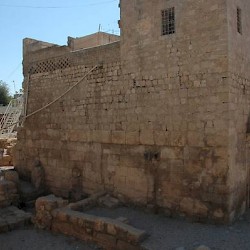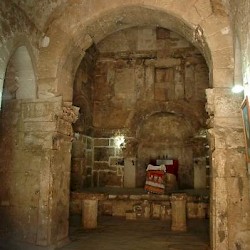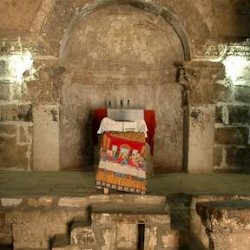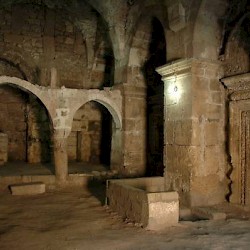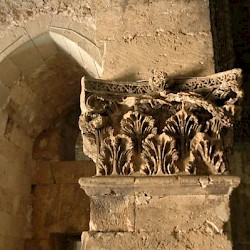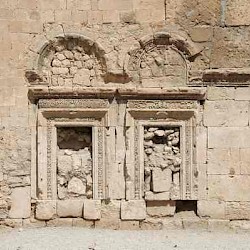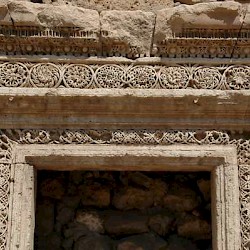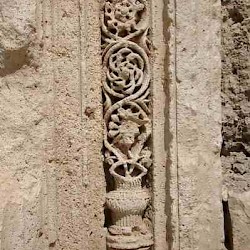Nisibis (Nusaybin)
Q1553052Nisibis (Greek Νίσιβις; modern Nusaybin): ancient town in Mesopotamia, famous for its late-Roman school.
Early History
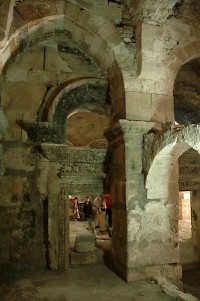
Situated along the road from Assyria to Syria, Nisibis has always been an important trade center. Here, travelers had to cross the small river Mygdonius ("fruit river" in Aramaic). There is not alternative for this road; to the south is the desert, where the average daytime temperature can be higher than 50°C.note Neither was it possible to take a more northerly route, because one would have to pass through the Izala mountains, which were well-known for their vines and arboriculture - and anyone who could produce wood, had a means to become rich in ancient Mesopotamia.
The Aramaic kingdom of "Naşibīna" is mentioned for the first time in an Assyrian source that can be dated to 901. Five years later, the small state became subject to its powerful eastern neighbor when king Adad-Nirari II (r. 911-891) captured the town. At first, it paid tribute, but later, it became an Assyrian province; its governors are, for example, mentioned in the limmu list. Nisibis remained loyal to the Assyrian kings until the very end, even after the Babylonians had captured Nineveh (612). According to the Fall of Nineveh Chronicle,note Nisibis was attacked by the Babylonian army in the ensuing year, which suggests that it remained loyal to the Assyrian dynasty, which, by now, resided in Harran.
We hear next to nothing about Nisibis during the Babylonian age, but we may assume that the land was sometimes ravaged by Medes, who reportedly even reached Harran at the beginning of the reign of Nabonidus (Nabonidus Cylinder). In 539, the Babylonian Empire became part of the Achaemenid Empire, and it is possible that Nisibis was a battlefield during the Persian civil war of 522/521, when Darius' general Vaumisa defeated the rebellious Armenians at a place called Izala, which may refer to the mountain range north of Nisibis.note There are other identifications, but as we will see below, armies that wanted to invade western Armenia, often used a road that passed along Nisibis.
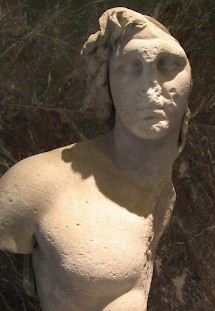
Again, we do not hear much about Nisibis in this period, although countless people must have used the important road from east to west, or the other way round. In 333, Darius III Codomannus managed to lure Alexander the Great away from the Euphrates to the land east of the Tigris, where he hoped to defeat the Macedonian conqueror at Gaugamela. As we all know, it turned out differently, and a Macedonian dynasty, the Seleucids, was to rule over the Near East. There appears to have been a Macedonian garrison in Nisibis,note and mints were struck in what was now called Antioch in Mygdonia - "Mygdonia" not only being a Macedonian toponym, but also a rendering of the Aramaic name of the country, which seems to have been derived from magda', "fruit".
The Seleucid king Antiochus III the Great is known to have visited Nisibis in 220note and the Astronomical Diaries refer to an army of Antiochus VI Dionysus near Nisibis in the summer of 144. A Stoic philosopher named Apollophanes is said to have come from Nisibis. However, although part of the Graeco-Macedonian world, Nisibis did not really become a hellenized city. The Aramaic language remained dominant and the official name "Antioch" was forgotten once the Parthians had replaced the Seleucids as masters of Mesopotamia. It is probably significant that Cassius Dio calls the Nisibenes barbarians, i.e., people who did not speak Greek.note
Parthians, Armenians, and Romans
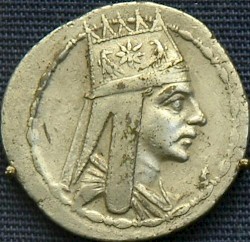
In 141 BCE, the Seleucids were expelled from Iran and Iraq by the Parthian king Mithradates I the Great (r.165-132). When the Seleucid king Demetrius II Nicator tried to reconquer the lost territories, he was defeated and taken captive (138). From now on, Nisibis and the old heartland of Assyria were part of Adiabene, a new kingdom that recognized the Parthians as its overlord. Its main enemy was Armenia, which rapidly expanded, due to the fact Parthian power was not yet fully developed, the Seleucids were losing ground, and Rome hadn't yet appeared on the stage. Adiabene and Nisibis were part of the kingdom of Tigranes II the Great, who was, however, expelled by the Roman commander Lucullus, whose legions captured Nisibis in 68/67 BCE.note When peace was concluded in 65, Tigranes regained control of the city.
For a century, Nisibis appears to have been part of Armenia, but it became Parthian again in the very confused situation of 36-38 CE, when a conflict in Armenia escalated into a civil war in the Parthian Empire, and the Roman governor of Syria, Lucius Vitellius, intervened. The Parthian king, Artabanus II, had been in exile for a while in Adiabene, and when he returned to power, he owed a present to his host, king Izates. The ruler of Adiabene received Nisibis, which had, apparently, been detached from Armenia.note It may be noted in passing that this Izates converted to Judaism. Later, Nisibis would serve as HQs of the Parthian king Vologases I, who tried to expell king Tigranes VI from Armenia (62).note
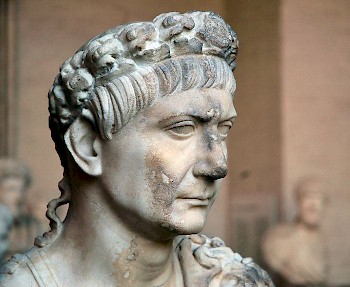
Rome was now clearly interested in Mesopotamia, and the emperor Trajan even annexed Armenia and Adiabene, later adding the south of Iraq. Nisibis was captured after a siege.note However, there were major disturbances - partly caused by Jewish rebels. When Trajan had died in 117, his successor Hadrian gave up the conquered land east of the Euphrates. Yet, it was clear that Rome was now the strongest power in this area, and it comes as no surprise to see the emperor Lucius Verus intervening again. It is possible that Nisibis was temporarily transferred from Adiabene to Osrhoene, another Parthian kingdom, situated to the west.
In 193, the emperor Pertinax died and the Roman Empire was torn apart by a civil war that was eventually won by Septimius Severus. He had to overcome Pescennius Niger, though, who was believed to have been supported by the Parthian kingdoms.note This (presumed) intervention was the excuse Severus needed to conquer Mesopotamia. He liberated Nisibis.note which had remained sympathetic to Rome, from a siege by Osrhoenian and Adiabenan troops, and captured Edessa. The newly conquered land was reorganized as a province, guarded by two legions: III Parthica at Rhesaena, halfway Nisibis and Edessa, and I Parthica at Singara, southeast of Nisibis. In the second phase of this war, Severus proceeded to Ctesiphon, the Parthian capital, which was sacked.
Some twenty years later, Severus' son Caracalla prepared a new war against the Parthians, but he was killed near Harran. His successor, Macrinus, inherited the war, and fought a battle against the Parthians near Nisibis. The outcome is presented in our sources as a Roman defeat - but the sources are generally hostile towards Macrinus, and perhaps the fight was less decisive than has been assumed. (Had the new emperor really been defeated, he would have been killed by his soldiers straight-away.) An armistice was concluded, and the Romans agreed to pay an indemnity.
Nisibis was, in these years, an important city for the Romans, which was recognized by the title of colonia. In fact, it was Rome's easternmost bulwark and an obstacle to Parthian armies heading for western Armenia, where a younger branch of the ruling Parthian dynasty, the Arsacids, ruled as kings. This made the city a natural target for Parthian aggression, and to prevent this, Caracalla may have prepared his preemptive strike. However, things went differently: in the Eastern Empire the Parthian dynasty was replaced by the Sasanians, the royal house of Persis. Having captured the Parthian capital, Ctesiphon, in 226, the first Sasanian king, Ardašir I, launched a war against Rome, and Nisibis was the natural target.
Persians and Romans
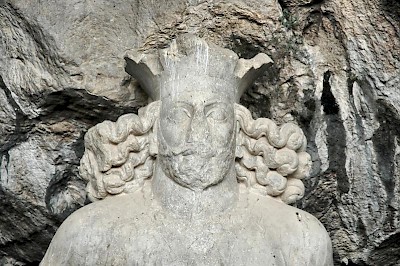
The siege in 230, which was unsuccessful, was the cause of a long war between the Sasanian Persians and the Romans. The young emperor Severus Alexander went east and attempted negotiations first, but when they failed, he invaded Iraq, where some inconclusive fighting took place in 233. A peace treaty may have been signed, which left everything as it had been: Nisibis Roman, and the Sasanians without access to western Armenia. It was a Sasanian defeat, because this handicapped them in their struggle against the last members of the Arsacid dynasty.
Ardašir's son and crown prince, the future king Shapur I, appears to have taken Nisibis and Harran in 235 or 236, after the violent death of Severus Alexander and the accession of Maximinus, or perhaps in 241. Whatever the year, however, the consequences are not in doubt: the Iranian army immediately proceeded to the west, and a new emperor, Gordian III, declared war by opening the Gates of Janus, an act not recorded over the preceding 170 years. Unfortunately, there's more that's not been recorded: our sources about this conflict are hopeless, although it is certain that the Romans invaded the Sasanian Empire in 244, recovered Harran and Nisibis,note and were defeated at Misiche. Gordian died under unclear circumstances and the new emperor, Philip, allowed the Sasanians to seize Armenia.
However, Armenia was not Philip's to give away: it was an independent kingdom, and its Arsacid kings held out against the Sasanians, who in an inscription on the walls of the Ka'bah-i Zardusht in Naqš-i Rustam blamed Philip, who "had lied about Armenia". War was renewed in 253, Shapur again invading the Roman Empire, and defeating a large force at Barbalissus. Next year, he recaptured Nisibis (254) and attacked Syria. The Romans found it hard to retaliate, because they were also under attack from the Germanic tribesmen who were later called Visigoths. In the end, however, the emperor Valerian mustered a large army, which was again defeated by Shapur. Valerian was taken captive, and it seemed that Shapur would conquer the now undergarrisoned eastern part of the Roman Empire.
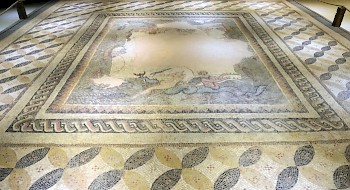
A local leader named Odaenathus of Palmyra, however, restored order, and continued the war. He was immensely successful:, he first recovered Nisibis for the Romans (262), and invaded the Sasanian Empire, even reaching its capital Ctesiphon.note Although he was assassinated in 267 and his wife Zenobia unsuccessfully tried to create an independent empire, in the end, Rome's eastern frontier had been restored.
It is not entirely clear who controlled Nisibis, but it was certainly Roman in 298, when a peace treaty was concluded. The Roman emperor Galerius had crushed the Sasanian forces of king Narseh, and Rome now even created provinces east of the Tigris. All trade between the two empires had to be conducted in Nisibis. A war that had lasted for more than seventy years, had come to an end with a Roman victory.
The School of Nisibis
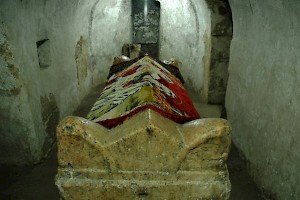
In 309, Nisibis' Christians received a new bishop, Jacob (†338). This was the age of the persecutions, but they were almost over: in 311, Galerius put an end to them. Not much later, his successor Licinius and his western colleague Constantine decided to restore ecclesiastical property (313, Edict of Milan), and Jacob started to build his church, which was completed in 320. Jacob attended the Council of Nicaea in 325 together with his disciple, Ephrem the Syrian (c.303-373), who was the first director of the "school of Nisibis".
Founded in 326, this was a major educational institution. Teaching was in Syriac (Middle Aramaic) and 800 to 1,000 students reportedly read theology, law, the liberal arts, and medicine. However, it was especially as a theological center that it became famous, although the teachers and students had to relocate on two occasions.
In 359/360, a bishop named Volageses and a priest named Akepsyma built a baptistery. It is the only monument that is still standing today, and it is used as a church and Jacob's mausoleum. Reliefs and other decorations suggest that the builders had access to large funds. Three years later, however, the school of Nisibis was unexpectedly closed.
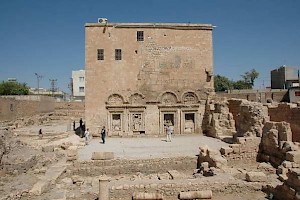
Persia and Rome had been fighting again for some time. There had been unsuccessful sieges of Nisibis in 338, 346, and 350), but in the end, the Sasanian king Shapur II (r.309-379) was successful when he defeated the emperor Julian and trapped his army. When Julian was killed in action, his successor Jovian concluded a peace treaty and gave the Sasanians what they wanted: the provinces east of the Tigris and Nisibis.note The town had to be evacuated in three days, and although the majority of the population went to Amida, the scholars eventually settled in Edessa, where they started again as "School of the Persians".
Among the students was Nestorius, the famous patriarch of Constantinople, whose teachings about the natures of Christ were condemned at the Council of Ephesus in 431. Almost sixty years later, the emperor Zeno closed the Edessan school, which was still suspected of Nestorian sympathies. Therefore, in 489, the scholars moved back to Nisibis.
Late Antiquity
Since the days of Jovian, the frontier between Rome and Persia was several kilometers west of Nisibis. The city was governed by a Sasanian military commander, and we know that there was a religious leader as well, a Magian. There was a Nestorian community, which had settled in Nisibis after the Council of Ephesus. Ephrem's Hymns to Nicomedia 10 and 11 refer to pagan incantations and astrology, and although they were written in the fourth century, they may be relevant for the fifth century as well. The same can be said about Ephrem's Prose Refutations of Mani, Marcion and Bar Daisan, which at least suggests the presence of Manichaeans and Gnostics in Nisibis. Judaism is better attested; the city was one of the main Jewish centers in the Diaspora.
The city also remained the trading place between the Roman and Sasanian Empires, although it was no longer the only one. The Codex Justinianus contains a law of Honorius and Theodosius II, dated to 408 or 409, that trade was only allowed in Nisibis, Callinicus (Raqqa in Syria), and Artaxata (south of modern Yerevan).note
Although there were minor disturbances of the peace in the fifth century, it was an essentially quiet period. During the reign of the Roman emperor Anastasius, however, fighting was renewed, and Nisibis was one of the Sasanians' main bases. To held it in check, Anastasius built a fortress at Dara, eighteen kilometers west of Nisibis, which was to be the focus of much violence during the reign of Justinian (r. 527-565). Nisibis, however, always remained Sasanian, until it was captured by the Arabs in 640.
